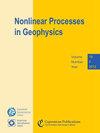Review article: Towards strongly coupled ensemble data assimilation with additional improvements from machine learning
IF 1.7
4区 地球科学
Q3 GEOSCIENCES, MULTIDISCIPLINARY
引用次数: 1
Abstract
Abstract. We assessed different coupled data assimilation strategies with a hierarchy of coupled models, ranging from a simple coupled Lorenz model to the state-of-the-art coupled general circulation model CFSv2 (Climate Forecast System version 2). With the coupled Lorenz model, we assessed the analysis accuracy by strongly coupled ensemble Kalman filter (EnKF) and 4D-Variational (4D-Var) methods with varying assimilation window lengths. The analysis accuracy of the strongly coupled EnKF with a short assimilation window is comparable to that of 4D-Var with a long assimilation window. For 4D-Var, the strongly coupled approach with the coupled model produces more accurate ocean analysis than the Estimating the Circulation and Climate of the Ocean (ECCO)-like approach using the uncoupled ocean model. Experiments with the coupled quasi-geostrophic model conclude that the strongly coupled approach outperforms the weakly coupled and uncoupled approaches for both the full-rank EnKF and 4D-Var, with the strongly coupled EnKF and 4D-Var showing a similar level of accuracy higher than other coupled data assimilation approaches such as outer-loop coupling. A strongly coupled EnKF software framework is developed and applied to the intermediate-complexity coupled model SPEEDY-NEMO and the state-of-the-art operational coupled model CFSv2. Experiments assimilating synthetic or real atmospheric observations into the ocean through strongly coupled EnKF show that the strongly coupled approach improves the analysis of the atmosphere and upper ocean but degrades observation fits in the deep ocean, probably due to the unreliable error correlation estimated by a small ensemble. The correlation-cutoff method is developed to reduce the unreliable error correlations between physically irrelevant model states and observations. Experiments with the coupled Lorenz model demonstrate that strongly coupled EnKF informed by the correlation-cutoff method produces more accurate coupled analyses than the weakly coupled and plain strongly coupled EnKF regardless of the ensemble size. To extend the correlation-cutoff method to operational coupled models, a neural network approach is proposed to systematically acquire the observation localization functions for all pairs between the model state and observation types. The following strongly coupled EnKF experiments with an intermediate-complexity coupled model show promising results with this method.综述文章:通过机器学习的额外改进实现强耦合集成数据同化
摘要我们用不同的耦合模式评估了不同的耦合数据同化策略,从简单的耦合Lorenz模式到最先进的耦合环流模式cfsv2(气候预报系统版本2)。在耦合Lorenz模式下,我们通过不同同化窗长的强耦合集合卡尔曼滤波(EnKF)和4d变分(4D-Var)方法评估了分析精度。短同化窗的强耦合EnKF与长同化窗的4D-Var的分析精度相当。对于4D-Var,与耦合模式的强耦合方法产生的海洋分析比使用非耦合海洋模式的估计海洋环流和气候(ECCO)方法更精确。用耦合准地转模型进行的实验表明,对于全阶EnKF和4D-Var,强耦合方法优于弱耦合和不耦合方法,强耦合的EnKF和4D-Var显示出与其他耦合数据同化方法(如外环耦合)相似的精度水平。开发了强耦合EnKF软件框架,并将其应用于中等复杂耦合模型speed - nemo和最先进的作战耦合模型CFSv2。通过强耦合EnKF将合成或真实大气观测同化到海洋的实验表明,强耦合方法改善了对大气和上层海洋的分析,但降低了对深海的观测拟合,这可能是由于小集合估计的误差相关不可靠。为了减少物理上不相关的模型状态与观测值之间的不可靠误差相关性,开发了相关截断方法。用耦合Lorenz模型进行的实验表明,与系综大小无关,由相关截止法得到的强耦合enkf比弱耦合和普通强耦合enkf产生更精确的耦合分析。为了将相关截断方法扩展到可操作耦合模型,提出了一种神经网络方法来系统地获取模型状态和观测类型之间所有对的观测定位函数。用中等复杂度的耦合模型进行了强耦合EnKF实验,结果表明该方法具有良好的效果。
本文章由计算机程序翻译,如有差异,请以英文原文为准。
求助全文
约1分钟内获得全文
求助全文
来源期刊

Nonlinear Processes in Geophysics
地学-地球化学与地球物理
CiteScore
4.00
自引率
0.00%
发文量
21
审稿时长
6-12 weeks
期刊介绍:
Nonlinear Processes in Geophysics (NPG) is an international, inter-/trans-disciplinary, non-profit journal devoted to breaking the deadlocks often faced by standard approaches in Earth and space sciences. It therefore solicits disruptive and innovative concepts and methodologies, as well as original applications of these to address the ubiquitous complexity in geoscience systems, and in interacting social and biological systems. Such systems are nonlinear, with responses strongly non-proportional to perturbations, and show an associated extreme variability across scales.
 求助内容:
求助内容: 应助结果提醒方式:
应助结果提醒方式:


